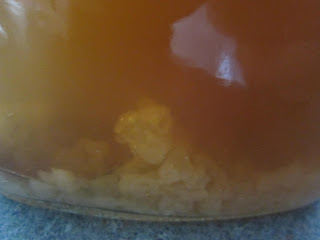I had recently been doing some reading about healthy eating and such things. I came across a grain I had heard of before but not anything past the yogurt style. We used to purchase
Liberte Kefir from the grocery store as opposed to yogurt. It is similar in texture but kefir is far more tangy tasting. It wasn't until recently that I discoved the many uses of these wonderful
Water Kefir Grains! (also known as Tibicos, tibi, sugar kefir grains, japanese water chrystals and California Bees)
Kefir Grains are cultures of healthy strains of bacteria and yeast. They feed on sugar and produce lactic acid, alcohol(usually less than 1%) and carbon dioxide thus making a unique tasting carbonated beverage. Drinking water kefir will supply your body with natural probiotics which aid in digestive health. Kefir also contains tryptophan, an essential amino acid, B vitamins and magnesium, known for protecting the nervous system, also producing a calming effect. There are many more benefits of this wonderful grain and they can be found all over the place on the wonderful web.
There a many links with information and recipes out there about water kefir grains but I have discovered a few that have been very helpful and informative:
http://zoevblog.com/2010/03/17/what-is-water-kefir-and-how-to-make-it/
http://www.yourkefirsource.com/
http://www.culturesforhealth.com/kefir
Aaron and I also found a local group of Kefir grains on facebook and have joined their group and managed to get some water kefir grains for free. The grains multiply each time you use them so you end up with an abundance and its very easy to share with others, which we also plan on doing. We decided to start a batch and just do a basic formula.
The basic formula is for every 1 cup of water (filtered) you add 1 tbsp. sugar and 1 tbsp. of grains. You can also add dried fruit (unsweetened, unsulfered) and some lemon wedges (organic) and a piece of a free range egg shell. You ferment for approx. 24hrs and then strain and enjoy! You don't want to use any fruit that may contain any chemicals or any metal utensils as this will harm and even kill your grains.
We simply added
4 cups water, 4 tbsp. sucanat ( raw sugar), 4 tbsp. kefir grains and a piece of free range egg shell for added nutrients. After 24 hours we weren't sure if it was working or if the grains were alive. There was a fermentation type smell so we thought it was doing something. We decided to let it ferment for another 24hrs, assuming the grains had been asleep. After about 36 hours there were some bubbles on the top and I knew it was well on its way. I tasted it at the 36 hour mark and it was a tad fizzy but not overly. It tasted much like... well, sucanat. I think once it is done fermenting, 48 hrs, we will each give it a try and then possibly add some pureed fruit or something for a boost of flavour.
Many people will add dried fruit and even a citrus wedge at the beginning for added nutrients for the grains as well as it adds a bit of flavour. To have flavoured water kefir people usually add some flavour (fresh fruit, purees, flavouring such as vanilla) after 24hrs of fermentation. They strain the grains and then add fresh fruit and allow it to sit and ferment (grains removed) for another 24 hrs. We didn't want to mess with our first batch so we did the simplest method. From reading I have noticed that many people just experiment with the grains and adding flavours. Since the water kefir grains multiply rapidly (almost double) each time they are used, it is something you can simply play around with. If you have a batch that doesn't turn out... simply toss and start again... nothing lost but a bit of sugar and possibly a few pieces of fruit.
 |
| Our first batch of water kefir! |
 |
| Water Kefir Grains at work. |




